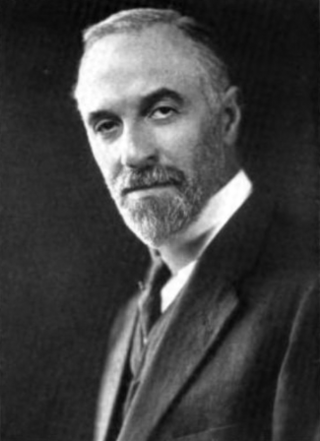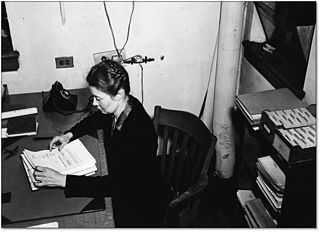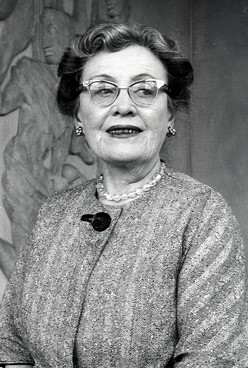
Edward Williams Morley was an American scientist known for his precise and accurate measurement of the atomic weight of oxygen, and for the Michelson–Morley experiment.

The American Chemical Society (ACS) is a scientific society based in the United States that supports scientific inquiry in the field of chemistry. Founded in 1876 at New York University, the ACS currently has more than 155,000 members at all degree levels and in all fields of chemistry, chemical engineering, and related fields. It is one of the world's largest scientific societies by membership. The ACS is a 501(c)(3) non-profit organization and holds a congressional charter under Title 36 of the United States Code. Its headquarters are located in Washington, D.C., and it has a large concentration of staff in Columbus, Ohio.

Frank Sherwood "Sherry" Rowland was an American Nobel laureate and a professor of chemistry at the University of California, Irvine. His research was on atmospheric chemistry and chemical kinetics. His best-known work was the discovery that chlorofluorocarbons contribute to ozone depletion.

Henry Taube, was a Canadian-born American chemist who was awarded the 1983 Nobel Prize in Chemistry for "his work in the mechanisms of electron-transfer reactions, especially in metal complexes." He was the second Canadian-born chemist to win the Nobel Prize, and remains the only Saskatchewanian-born Nobel laureate. Taube completed his undergraduate and master's degrees at the University of Saskatchewan, and his PhD from the University of California, Berkeley. After finishing graduate school, Taube worked at Cornell University, the University of Chicago and Stanford University.

Armand Paul Alivisatos is an American chemist and academic administrator who has served as the 14th president of the University of Chicago since September 2021. He is a pioneer in nanomaterials development and an authority on the fabrication of nanocrystals and their use in biomedical and renewable energy applications. He was ranked fifth among the world's top 100 chemists for the period 2000–2010 in the list released by Thomson Reuters.

Kendall Newcomb Houk is a Distinguished Research Professor in Organic Chemistry at the University of California, Los Angeles. His research group studies organic, organometallic, and biological reactions using the tools of computational chemistry. This work involves quantum mechanical calculations, often with density functional theory, and molecular dynamics, either quantum dynamics for small systems or force fields such as AMBER, for solution and protein simulations.
Gilbert Stork was an organic chemist. For a quarter of a century he was the Eugene Higgins Professor of Chemistry Emeritus at Columbia University. He is known for making significant contributions to the total synthesis of natural products, including a lifelong fascination with the synthesis of quinine. In so doing he also made a number of contributions to mechanistic understanding of reactions, and performed pioneering work on enamine chemistry, leading to development of the Stork enamine alkylation. It is believed he was responsible for the first planned stereocontrolled synthesis as well as the first natural product to be synthesised with high stereoselectivity.
Tobin Jay Marks is the Vladimir N. Ipatieff Professor of Catalytic Chemistry, Professor of Material Science and Engineering, Professor of Chemical and Biological Engineering, and Professor of Applied Physics at Northwestern University in Evanston, Illinois. Among the themes of his research are synthetic organo-f-element and early-transition metal organometallic chemistry, polymer chemistry, materials chemistry, homogeneous and heterogeneous catalysis, molecule-based photonic materials, superconductivity, metal-organic chemical vapor deposition, and biological aspects of transition metal chemistry.
Izaak Maurits (Piet) Kolthoff was an analytical chemist and chemistry educator. He is widely considered the father of analytical chemistry for his large volume of published research in diverse fields of analysis, his work to modernize and promote the field, and for advising a large number of students who went on to influential careers of their own.
Hermann Irving Schlesinger was an American inorganic chemist, working in boron chemistry.

Krzysztof "Kris" Matyjaszewski is a Polish-American chemist. He is the J.C. Warner Professor of the Natural Sciences at the Carnegie Mellon University Matyjaszewski is best known for the discovery of atom transfer radical polymerization (ATRP), a novel method of polymer synthesis that has revolutionized the way macromolecules are made.
The Stieglitz rearrangement is a rearrangement reaction in organic chemistry which is named after the American chemist Julius Stieglitz (1867–1937) and was first investigated by him and Paul Nicholas Leech in 1913. It describes the 1,2-rearrangement of trityl amine derivatives to triaryl imines. It is comparable to a Beckmann rearrangement which also involves a substitution at a nitrogen atom through a carbon to nitrogen shift. As an example, triaryl hydroxylamines can undergo a Stieglitz rearrangement by dehydration and the shift of a phenyl group after activation with phosphorus pentachloride to yield the respective triaryl imine, a Schiff base.

Julius Oscar Stieglitz was an American chemist of German Jewish origin. He was a teacher and organic chemist with a major interest in pharmaceutical and medicinal chemistry. He is known for the Stieglitz rearrangement, a rearrangement reaction in organic chemistry which commonly involves the formation of imines from hydroxylamines through a carbon to nitrogen shift, comparable to the key step of a Beckmann rearrangement.

Peter John Stang is a German American chemist and Distinguished Professor of chemistry at the University of Utah. He was the editor-in-chief of the Journal of the American Chemical Society from 2002 to 2020.

Herbert Newby McCoy was an American chemist who taught at the University of Chicago and the University of Utah and was the vice-president of Lindsay Light & Chemical Company. He contributed numerous papers on physical chemistry, radioactivity and rare earths.
Dr. Joseph Fried was a Polish-American organic chemist, member of the National Academy of Sciences and the American Academy of Arts and Sciences. He held 200 patents on chemical compounds, with 43 listing him as the sole holder. He was a professor of chemistry and biochemistry at the University of Chicago. Fried discovered fluorohydrocortisone, a chemical used to treat adrenal disorders. He was also director of the organic chemistry at the Squibb Institute. His discoveries were instrumental to the creation of medications to treat inflammatory disorders including as arthritis, psoriasis, and various skin allergies. National Academies Press called him "an outstanding organic chemist who made very special contributions to the field of medicine". Professor Elias James Corey had this to say of Fried: "He was an outstanding, highly creative scientist who straddled both the worlds of pharmaceutical research and academic science. He was one of my heroes, and I've always thought of him as a model scientist of great character and great human warmth."

Hoylande Denune Young Failey was an American chemist. During World War II she worked at the Manhattan Project's Metallurgical Laboratory. After the war she became the first woman to be appointed as a division head at the Argonne National Laboratory, and the first woman to chair the Chicago Section of the American Chemical Society.

Mary Lura Sherrill was recognized for her achievements in chemical research, particularly the synthesis of antimalarial compounds, and for her teaching at Mount Holyoke College. In 1947, she received the Garvan Medal, an award for women in chemistry.

Judith P. Klinman is an American chemist, biochemist, and molecular biologist known for her work on enzyme catalysis. She became the first female professor in the physical sciences at the University of California, Berkeley in 1978, where she is now Professor of the Graduate School and Chancellor's Professor. In 2012, she was awarded the National Medal of Science by President Barack Obama. She is a member of the National Academy of Sciences, American Academy of Arts and Sciences, American Association for the Advancement of Science, and the American Philosophical Society.

Agnes Fay Morgan was an American chemist and academic. She was the longtime chair of the home economics program at the University of California. Her program was strongly grounded in science, and students admitted into the program were required to have a level of science education that was not typical of home economics programs at the time. Morgan was one of the earliest married female college professors in the United States.













